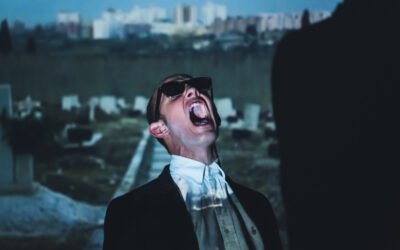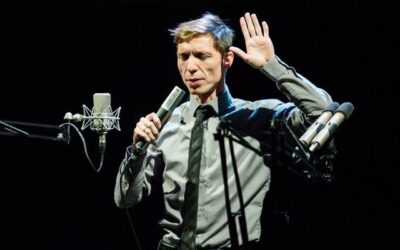Two important parallel discourses – that of the performance archive and that of the sound archive – combine in the LMYE collection to address a kind of ‘sounding out’ or ‘re-sounding’ of the archive. The idea of listening to the past is stretched into different directions, addresses different eras, and perhaps especially works with different modalities and methodologies. Every time archives are engaged across the auralia.space website, we are encouraged to think of different ways in which the past may be ‘usable’. Lois Parkinson Zamora writes in her preface to The Usable Past (1997) that the adjective
implies the active engagement of a user or users, through whose agency collective and personal histories are constituted. The term thus obviates the possibility of innocent history, but not the possibility of authentic history when it is actively imagined by its user(s).’ (1997: ix)
In the performances discussed in interviews with Valentijn Dhaenens, Filippo Ceredi and Oliver Zahn – which respectively ‘use’ an archive of great speeches of 2,500 years of history, the domestic archive of a lost brother, and an archive of oral cultures of Germans expelled from non-German lands following World War Two – a kind of re-appropriation is at work, often aimed at acquiring agency via a disavowal of ‘innocence’. This is particularly true in matters discussed by Dhanaens and Zahn: in BigMoutH (2011) Dhanaens re-performs speeches by Goebbels, Patton, King Baudouin, altering them in tone and in scope; in In Praise of Forgetting (2019) Zahn plays back an archive of folk songs that was supposed to be passed on to him and hadn’t. Both explore the consequences of what a sounding or not-sounding has done to the world, the word becoming flesh, the ‘felicity’ or ‘infelicity’ of utterances as J.L. Austin (1962) would have it; both also explore what we might term ‘overly remembered’ sonic events versus the ones that time has made inaudible. What happens when a speech changes the world? What happens when we also posit what I have elsewhere theorised as the ‘unhappened’ as an archival category (Pitrolo 2015)? How might a performance attempt to set a certain record straight? Ceredi, on the other hand, explains in his Gallery interview how he delved into the personal archive of his brother –who disappeared when the artist was a young boy – recomposing his sibling through the photographs, tapes, book and letters he left behind. In Between Me and P. (2016) it is perhaps Ceredi’s own innocence that is at stake: to confront an archive is always to embark on a work of anamnesis and not mere mneme, as Ricoeur writes in Memory, History, Forgetting (2004). In a pragmatic practice of recollection one re-members for a reason: ‘the exercise of memory is its use’ (Ricoeur 2004: 57).
The personal archive is also the subject of Konstantinos Thomaidis’s work A Voice Is. A Voice Has. A Voice Does (2018), an experiment in what he terms ‘autobiophony’. In Thomaidis’s Salon exchange with Brandon LaBelle the piece is ‘used’ to think about distance and proximity between the self and the personal archive, always implicated in turn to a larger cultural and historical one. In the piece, Thomaidis stages himself in the third person as the character of ‘Konstantinos’ to think also about the effects of thinking about one’s historical past as somebody else’s: a positioning that, as LaBelle puts it, points towards the ways in which ‘our stories, the particularities of those stories, also speak towards larger cultural, historical stories’ (LMYE Salon #2, 2021: 7). The play between the sentimentality of the personal archive and the larger questions it poses to the listener is at the heart of the salon between the two thinkers, who encourage us to think about not only what archives we might listen to, but our position in doing so: where we are listening from, and perhaps even on behalf of whom, is a central concern the moment we take an archive into the sphere of the performative, and thus also of agency.
From vocal archaeology we move to archaeoacoustics in the Salon between Annie Goh and Miriam Kolar, in which they discuss the work of ‘re-sounding’ the archaeological site at Chavín de Huántar in Peru. As Goh introduces her guest, she addresses a certain academic resistance in using sound and listening as modes of historical investigation, a resistance amply undone by the conversation between the two which time and again points to the importance of the sonic in experimental archaeology. At the same time however, this Salon also opens the door onto something we might call ‘good speculation’. As Kolar asserts,
to me, this is really good archaeological science: doing the best documentation we can with lots of annotation, but then making this space for speculation and imagination and possibility. (LMYE Salon #5, 2021: 10)
Does the sonic somehow open up a speculative terrain? If so, can we use it to enrich our disciplines and our institutions or will it always be regarded with a certain nervousness? And in turn, can we use that nervousness?
Finally and in relation to the sonic and institutional evasion, Ella Finer’s volume Acoustic Commons and the Wild Life of Sound, forthcoming on Errant Bodies, looks at sound’s capacity to escape: from buildings, from institutions, from disciplinary categorisation. In Finer’s Library about the book, she explains how a recording of a swan heard in the British Library Sound Archive – kept in the wildlife collection, but ‘wilder than wildlife’, in her words – moved her to craft a set of essays to consider sounds that escape their boundaries and enter into conversation with one another:
the swan in the archive speaks to the voices leaking out of the Houses of Parliament, of the House of Commons, and then almost absurd or surreal moments happen where I imagine a swan being heard in the Houses of Parliament or in amongst the sounds of Takis’s artwork in the Tate Gallery. (LMYE Library #2, 2021: 2)
Wildness in Finer’s project becomes a kind of necessary underside to the blind faith we might have in archival practices, in which ‘foreign objects’ show up that dismantle the whole machine: ‘like queerness, wildness names, while rendering partially opaque, what hegemonic systems would interdict or push to the margins.’ (Halberstam and Nyong’o 2018: 453).
Works Cited
Austin, J.L. (1962) How to Do Things with Words, Oxford: Oxford University Press.
Halberstam, Jack and Nyong’o, Tavia (2018) “Introduction: Theory in the Wild” South Atlantic Quarterly, 117 (3): pp. 453–464.
Pitrolo, Flora (2015) “Future Future: the Unhappened as Archival Category” Mnemoscape #2: In the Presence of Absence, http://www.mnemoscape.org/#!future-future-by-flora-pitrolo/c1gfo.
Ricoeur, Paul (2004) Memory, History, Forgetting, Chicago: University of Chicago Press.
Radosavljević, Duška; Pitrolo, Flora; Bano, Tim; Goh, Annie; Kolar, Miriam (2021) LMYE Salon #5: Annie Goh & Miriam Kolar – Performing Archaeoacoustics, Auralia.Space, Royal Central School of Speech and Drama, https://doi.org/10.25389/rcssd.14061611.v1.
Radosavljević, Duška; Pitrolo, Flora; Bano, Tim; LaBelle, Brandon; Thomaidis, Konstantinos (2021) LMYE Salon #2: Brandon LaBelle & Konstantinos Thomaidis – Vocal Positionings, Auralia.Space, Royal Central School of Speech and Drama, https://doi.org/10.25389/rcssd.14013566.v1.
Radosavljević, Duška; Pitrolo, Flora; Salazar Cardona, Juan Felipe; Finer, Ella (2021) LMYE Library #2: Ella Finer – Acoustic Commons, Auralia.Space, Royal Central School of Speech and Drama, https://doi.org/10.25389/rcssd.14014166.v1.
Zamora, Lois Parkinson (1997) The Usable Past: The Imagination of History in Recent Fiction of the Americas, Cambridge: Cambridge University Press.







